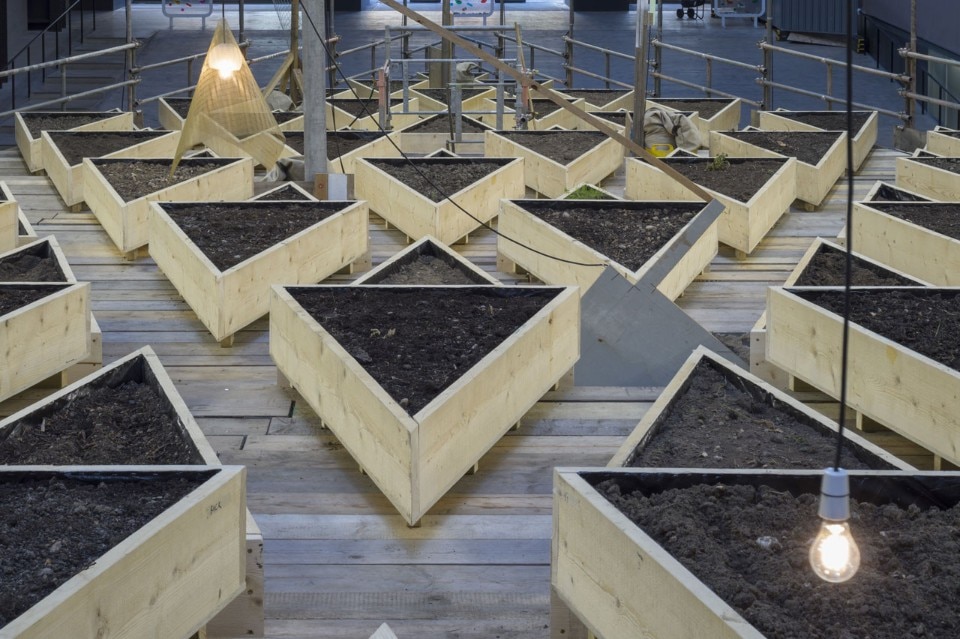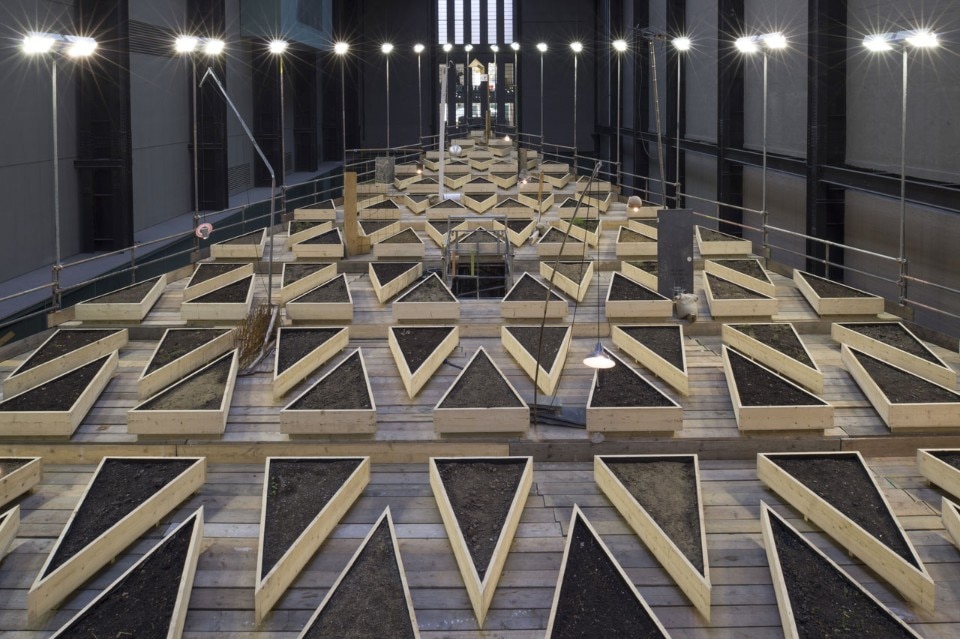This year the task of dealing with the sublime of the Tate Modern’s Turbine Hall has fallen to Abraham Cruzvillegas. The Mexican artist has created two triangular platforms, arranged symmetrically along two sides of the stairwell that consists the only element with the capacity (as well as the courage) to interrupt the view across the great empty space of the hall. The two platforms have stepped cross-sections and are raised up on a structure made from metal tubing that rests on the concrete floor via a series of square-sectioned columns arranged at regular intervals.
Silence is golden
The works by Abraham Cruzvillegas at the Tate Modern and by Edmund de Waal at the Royal Academy of Arts are an important reminder of the ability to observe in silence.

View Article details
- Francesco Zuddas
- 24 November 2015
- London

Above the two platforms, made from wooden boarding that contributes to the overall impression of a scaffolding on a building-site, are arranged 240 wooden planters, also with a triangular shape and arranged in an alternating fashion so that two contiguous triangles constitute a parallelogram. Each planter is filled with soil taken from parks and gardens across London. To complete the installation is a dual system of lighting. Soft light emanates from a number of lamps arranged in no particular order among the tubs of earth and made from materials salvaged from construction-sites around the gallery. Meanwhile, distributed at regular intervals along the edge of the two triangular platforms, a series of high-output reflectors appear to highlight the scene of an event in progress. Instead, nothing happens.
The soil taken from London’s gardens probably brings with it life-forms of some kind – seeds, roots or larvae that will perhaps evolve. Or maybe not. To a public that increasingly expects events that they can interact with, the planters in Cruzvillegas’s Empty Lot at most offer the hope of an event that very probably won’t happen. Not, at least, during the brief spell of time in which the work will remain installed on the south side of the Thames.
Onto the silence of the great hall is superimposed the silence of a non-event space. Is this a statement of submission to the sacred space that Herzog & de Meuron wanted to create – the cloister of the Tate monastery? The answer is less immediate that what might appear and the double game of Empty Lot begins to become clearer when the other face of Janus is observed. The decision to anchor itself to the stairwell in the centre of the hall divides what is above from what is below. Above, a barren landscape, looked out upon as from a viewing platform, that can never be reached. A reaffirmation of the sublime of the great hall, the possibility of capturing the infinite that is consumed only with the eyes. Below the annihilation of the sublime, the affirmation of a space without quality – not a space to explore, as instead stated in the official brochure, almost as if to indicate the impossibility of conceiving – in that space – the passivity of the spectator.
A place where the memory of the slides created by Matthew Pillsbury in 2007 still echoes, hoped-for manifesto for a participatory art, of a much more literal experience. A place that shows the scar of the great crack dug into the concrete floor by Doris Salcedo, exaltation of the gigantism of a space that, foreseen or otherwise in the mind of the artist, did not relieve it of a direct physical relationship with the visitor – registered in an exhilarating manner in the fractures of those who, into the crack of the artist, with an irrepressible desire for interactivity, managed to fall.
The work of Cruzvillegas is an important reminder of the ability to observe, observe in silence. Perhaps one should expect something more from an installation of such dimensions as to exceed the field of art and enter in that of architecture-art of the built space, necessarily to experience? Adding – above – a promised space, visible but not accessible, and subtracting – below – another that it would be hard to experience a desire to cross, Empty Lot ultimately achieves the fusion between work of art and architectural space, consuming it in the silence of the sublime.
“White can be erasure. It can be addition.” The words of Edmund de Waal, commenting on his exhibition currently showing at the Royal Academy of Arts, sums up a desire to reclaim the expressive capacity of silence.
White is a masterful display of a personal obsession. The work of de Waal is the vindication of the non-banality of the white, presented as a necessary condition to the way in which man physically and psychically relates to reality.
The exhibition is a collection of white objects selected by the artist and borrowed from eras, places and authors that lie as far apart as possible, including a pillar from the 1st century B.C. from Saudi Arabia, the palette of JMW Turner, the score of 4:33” by John Cage, a drawing by Kazimir Malevich from 1919, and a number of objects in (white) porcelain produced by de Waal himself.
Preferring to the total silence of a “white cube gallery” that attempts to avoid the unwanted interference of the space in the work of art, the noisy silence of an archive space overflowing with objects that offer information (the library and the Print Room in which the exhibition is displayed), de Waal makes a choice seemingly opposed to the superimposition of absolute silences that has been installed in the Turbine Hall. However, the end is the same.
“If a fine silence has never been written let’s be quiet and leave the facts to speak” said an Italian song. The Tate and the Royal Academy of Arts now offer, for a few weeks, two examples of the writing of a fine silence. The quiet before the next storm.
© all rights reserved
until 3 April 2016
Hyundai Commission 2015
Abraham Cruzvillegas: Empty Lot
Tate Modern, Turbine Hall, London
until 3 January 2016
White, a project by Edmund De Waal
Royal Academy of Arts, London